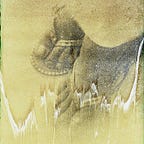Detailed instructions on how to make 3D animated GIFs
Please see this story for some examples of 3D animated GIFs. This story here is for the detailed instructions on how to make them. As noted in the prior story, the cameras that produce these 3D images take 4 images at one time through 4 separate lenses, each image from a slightly different angle. When these 4 images are overlaid and animated in rapid sequence, they give a 3D effect.
Needed: Nishika N8000, Nishika N9000, or Nimslo 3D camera; 35mm film; flash (optional); Adobe Photoshop.
See camera instructions for how to take pictures that give the best 3D effect, but basically you want your main subject to be about 6–10 feet away with other objects in the foreground and background. Shoot the film, process it, and get the negatives scanned. If you don’t have your own scanner (they’re cheap!), give the film lab instructions to scan each group of 4 images together into a single jpg file. BTW, the 4 images take up two regular 35mm frames, so you get 18 3D image sets from a 36-exposure roll of film.
Instructions:
1) scan all four images in a single scan to assure consistent image characteristics across all four images.
2) open the file in Photoshop and adjust levels, contrast, curves, etc. to your liking on the single four-image file.
3) clean up dust per your liking.
4) save the file.
5) create four separate single-image files (by cropping and Save As…) under a common name with sequential numbers 1, 2, 3, 4 at the end of the file name.
6) go to Files > Scripts > Load files into Stack… Browse and select the sequentially numbered single-image files; do not check the “Attempt to Automatically Align Source Images” box.
7) you now have a stack of four images, each its own layer; working from the bottom up, click off layers 1 and 2, and turn layer 3 opacity to about 30% (keeping layer 4 opacity at 100%); using the Move Tool, align the ghost image of layer 3 to the underlying layer 4 image using the subject’s eyes or other feature you want to be the “central point” or axis around which the 3D animation swings.
8) do the same thing for the other layers: click on layer 2 and set it at 30% opacity and set layer 3 at 100% opacity; align the ghost image of layer 2 to the underlying layer 3 image; click on layer 1 and set it at 30% opacity and set layer 2 at 100% opacity; align the ghost image of layer 1 to the underlying layer 2 image.
9) make sure that all layers are clicked on and set at 100% opacity; you’ll see that through the alignment process the frame edges are no longer aligned so you need to crop. Crop once with all layers clicked on, and crop again with only layer 4 clicked on (this way you get rid of mis-aligned edges on both the right and left sides).
10) go to Window > Animation and click on the drop-down icon at the upper right, and select Make Frames from Layers.
11) your four image layers should now appear as a sequence of four frames; adjust the time each frame will appear in the animation with the drop-down selector under each frame (0.2 seconds is a good start).
12) the gif you want to create will be a loop that runs continuously, so you usually want the frame sequence to be 1-2-3-4-3-2. That means you need to copy frames 3 and 2 and add them to the end of the sequence, using the copy icon at the bottom of the animation window and dragging the copied frame in place accordingly; somewhere along here you want to save the four image stack and the animation you created (it’s all saved as a single psd file).
13) to create the gif file, go to File > Save for Web and Devices… at the lower right, under Looping Options, select Forever; click Save and you have a gif file of your animation.
14) find a host, like tinypic.com, to host your gif file (upload the gif file as an “image”) from which you can link and embed, or upload directly as an image to your Medium story. You might have a problem with the gif file size being too big to upload to tinypic or embed in tumblr, or the size of the final GIF is not to your liking. You can resize by going back to the psd file you saved, go to Image > Image Size and adjust the size and save the file under a different name. 800 pixels high at 72 dpi should give a gif file around 2–3.5 MB and that should work fine in tinypic, tumblr, and Medium with no issues.
15) entertain and annoy friends and neighbors.
